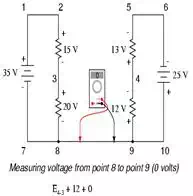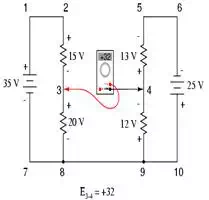Kirchhoff’s Voltage Law
(KVL)
Let’s take another look at
our example series circuit, this time numbering the points in the circuit for
voltage reference:

If we were to connect a
voltmeter between points 2 and 1, red test lead to point 2 and black test lead
to point 1, the meter would register +45 volts. Typically the “+” sign is not
shown, but rather implied, for positive readings in digital meter displays.
However, for this lesson the polarity of the voltage reading is very important
and so I will show positive numbers explicitly:
![]()
When a voltage is specified
with a double subscript (the characters “2-1” in the notation “E2-1”), it means the voltage at the first
point (2) as measured in reference to the second point (1). A voltage specified
as “Ecd” would mean the voltage as indicated by
a digital meter with the red test lead on point “c” and the black test lead on
point “d”: the voltage at “c” in reference to “d”.

If we were to take that same
voltmeter and measure the voltage drop across each resistor, stepping around
the circuit in a clockwise direction with the red test lead of our meter on the
point ahead and the black test lead on the point behind, we would obtain the
following readings:


We should already be familiar
with the general principle for series circuits stating that individual voltage
drops add up to the total applied voltage, but measuring voltage drops in this
manner and paying attention to the polarity (mathematical sign) of the readings
reveals another facet of this principle: that the voltages measured as such all
add up to zero:

This principle is known
as Kirchhoff’s Voltage Law (discovered in 1847 by Gustav R.
Kirchhoff, a German physicist), and it can be stated as such:
“The
algebraic sum of all voltages in a loop must equal zero”
By algebraic, I
mean accounting for signs (polarities) as well as magnitudes. By loop,
I mean any path traced from one point in a circuit around to other points in
that circuit, and finally back to the initial point. In the above example the
loop was formed by following points in this order: 1-2-3-4-1. It doesn’t matter
which point we start at or which direction we proceed in tracing the loop; the
voltage sum will still equal zero. To demonstrate, we can tally up the voltages
in loop 3-2-1-4-3 of the same circuit:

This may make more sense if
we re-draw our example series circuit so that all components are represented in
a straight line:

It’s still the same series
circuit, just with the components arranged in a different form. Notice the
polarities of the resistor voltage drops with respect to the battery: the
battery’s voltage is negative on the left and positive on the right, whereas
all the resistor voltage drops are oriented the other way: positive on the left
and negative on the right. This is because the resistors are resisting the
flow of electrons being pushed by the battery. In other words, the “push”
exerted by the resistors against the flow of electrons must be
in a direction opposite the source of electromotive force.
Here we see what a digital
voltmeter would indicate across each component in this circuit, black lead on
the left and red lead on the right, as laid out in horizontal fashion:

If we were to take that same
voltmeter and read voltage across combinations of components, starting with
only R1 on the left and progressing across
the whole string of components, we will see how the voltages add algebraically
(to zero):

The fact that series voltages
add up should be no mystery, but we notice that the polarity of
these voltages makes a lot of difference in how the figures add. While reading
voltage across R1, R1—R2, and R1—R2—R3(I’m using a “double-dash” symbol “—” to represent the series connection
between resistors R1, R2, and R3), we see how the voltages measure successively larger
(albeit negative) magnitudes, because the polarities of the individual voltage
drops are in the same orientation (positive left, negative right). The sum of
the voltage drops across R1, R2, and R3 equals 45 volts, which is the same as the battery’s
output, except that the battery’s polarity is opposite that of the resistor
voltage drops (negative left, positive right), so we end up with 0 volts
measured across the whole string of components.
That we should end up with
exactly 0 volts across the whole string should be no mystery, either. Looking
at the circuit, we can see that the far left of the string (left side of R1: point number 2) is directly connected
to the far right of the string (right side of battery: point number 2), as
necessary to complete the circuit. Since these two points are directly
connected, they are electrically common to each other. And, as
such, the voltage between those two electrically common points must be
zero.
Kirchhoff’s Voltage Law
(sometimes denoted as KVL for short) will work for any circuit
configuration at all, not just simple series. Note how it works for this
parallel circuit:

Being a parallel circuit, the
voltage across every resistor is the same as the supply voltage: 6 volts.
Tallying up voltages around loop 2-3-4-5-6-7-2, we get:

Note how I label the final
(sum) voltage as E2-2. Since we began
our loop-stepping sequence at point 2 and ended at point 2, the algebraic sum
of those voltages will be the same as the voltage measured between the
same point (E2-2), which of course must be zero.
The fact that this circuit is
parallel instead of series has nothing to do with the validity of Kirchhoff’s
Voltage Law. For that matter, the circuit could be a “black box”—its component
configuration completely hidden from our view, with only a set of exposed
terminals for us to measure voltage between—and KVL would still hold true:

Try any order of steps from
any terminal in the above diagram, stepping around back to the original
terminal, and you’ll find that the algebraic sum of the voltages always equals
zero.
Furthermore, the “loop” we
trace for KVL doesn’t even have to be a real current path in the closed-circuit
sense of the word. All we have to do to comply with KVL is to begin and end at
the same point in the circuit, tallying voltage drops and polarities as we go
between the next and the last point. Consider this absurd example, tracing
“loop” 2-3-6-3-2 in the same parallel resistor circuit:


KVL can be used to determine
an unknown voltage in a complex circuit, where all other voltages around a
particular “loop” are known. Take the following complex circuit (actually two
series circuits joined by a single wire at the bottom) as an example:

To make the problem simpler,
I’ve omitted resistance values and simply given voltage drops across each
resistor. The two series circuits share a common wire between them (wire
7-8-9-10), making voltage measurements between the two
circuits possible. If we wanted to determine the voltage between points 4 and
3, we could set up a KVL equation with the voltage between those points as the
unknown:





Stepping around the loop
3-4-9-8-3, we write the voltage drop figures as a digital voltmeter would
register them, measuring with the red test lead on the point ahead and black
test lead on the point behind as we progress around the loop. Therefore, the
voltage from point 9 to point 4 is a positive (+) 12 volts because the “red
lead” is on point 9 and the “black lead” is on point 4. The voltage from point
3 to point 8 is a positive (+) 20 volts because the “red lead” is on point 3
and the “black lead” is on point 8. The voltage from point 8 to point 9 is
zero, of course, because those two points are electrically common.
Our final answer for the
voltage from point 4 to point 3 is a negative (-) 32 volts, telling us that
point 3 is actually positive with respect to point 4, precisely what a digital
voltmeter would indicate with the red lead on point 4 and the black lead on
point 3:

In other words, the initial
placement of our “meter leads” in this KVL problem was “backwards.” Had we
generated our KVL equation starting with E3-4 instead of E4-3, stepping around the same loop with the opposite meter lead
orientation, the final answer would have been E3-4 = +32 volts:

It is important to realize
that neither approach is “wrong.” In both cases, we arrive at the correct
assessment of voltage between the two points, 3 and 4: point 3 is positive with
respect to point 4, and the voltage between them is 32 volts.